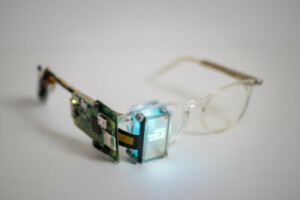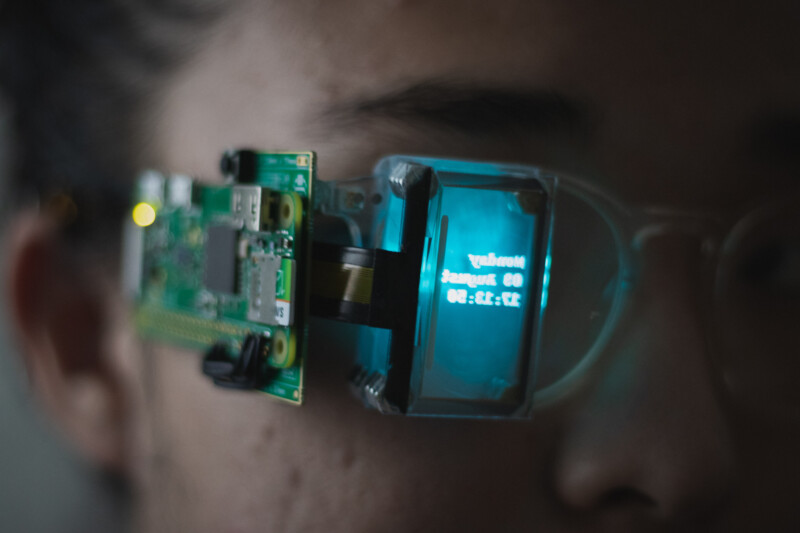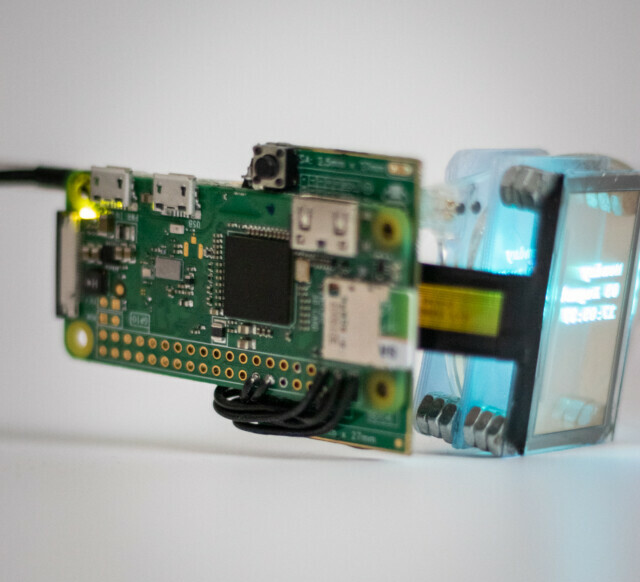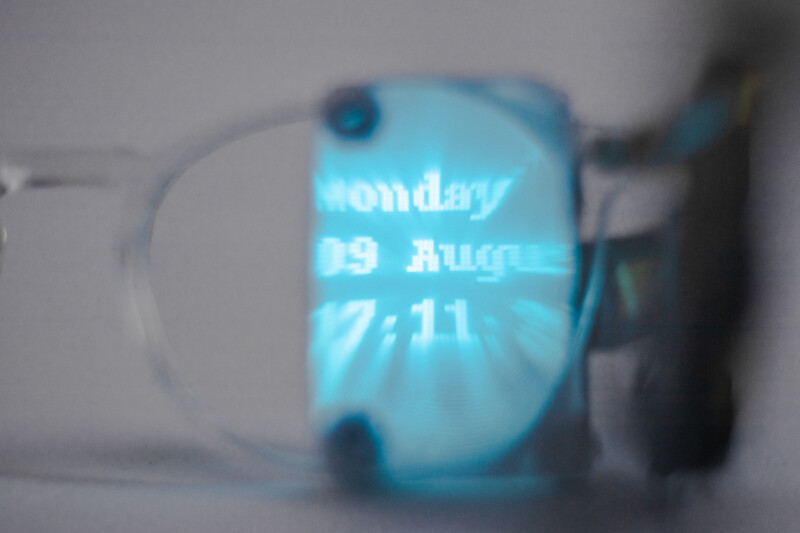
Transparent OLED Smart Glasses
Kevin Choi’s Transparent OLED Glasses with Fresnel Lenses

We’ve seen a lot of people making glasses out of our transparent OLEDs, but this is the first iteration we’ve seen that uses lenses to make the display viewable. Kevin Choi (@k.choiii) shared some details of his build with us. Check out his page for more images (story highlight).
From Kevin:
Part List:

- Transparent OLED
- OLED Breakout Board
- Raspberry Pi Zero W
- Adafruit DS3231 RTC module
- 3.7v 300mAh battery
- TP4056 battery charge protection circuit
- Fresnel magnifying lenses
- Glasses
Design inspiration for these glasses came from JLaservideo’s EDITH smart glasses.
Description

Connections
These glasses are running on a Raspberry Pi Zero W using the I2C interface. Four wires are soldered from Pi pins 1, 3, 5, and 6 to the 3.3v, D1, D0, and GND pins respectively on the Crystalfontz CFA 10105 breakout board. The same four pins are also connected to an Adafruit real time clock to maintain time, even when the glasses are turned off.
On the breakout board, jumper pins SDA=SDA and BS1=1 are soldered for I2C interface. The male pin headers were desoldered from the breakout board for a lower-profile design, and also so that the PCB could sit next to my face without poking me.
The breakout board is then connected to the Crystalfontz transparent OLED display.
The RPi also has pins 14 and 16 soldered to a small normally-open push button to allow for various GPIO stuff, such as killing and starting the python script which displays the time and date.

Power
For power, a 3.7v 300mAh LiPo soldered to a TP4056 charge protection module is then soldered to the pads on the back of the RPi behind the micro-USB power port.

Optics
To see the display itself, some optical magnification was needed as our eyeballs cannot focus on anything this close to our face. I used eight total Fresnel magnifying lenses, with four layered on the inside of the glasses, four more layered on the outside of the glasses, and then finally the transparent OLED outside of that.
Magnifiers are most effective when there is some distance between the magnifier and the thing you want to see, so there are about 7mm between the two Fresnel groupings, and another 7 between the Fresnel and the OLED. The
number of Fresnel lenses used and the distance needed between the three layers will probably be very different if you wear corrective glasses.
Viewability of the display itself is crystal clear, but because I have essentially made a fixed focal length lens to view it, everything past the display is very blurry. A bit like wearing a very strong prescription pair of glasses if you have 20/20 vision, or vice versa if you don’t.
So really, the theoretical benefits of a transparent display allowing you to see through it are negated and it may as well be a regular non-transparent display. But from a sci-fi perspective they still look super cool.
Since the display only covers half of the right eye, depth perception still works just fine so once I look away from the display. It’s easy to kind of “unfocus” on it and let it fade away into the foreground while I focus on everything else in the distance. However my entire far right peripheral is completely covered by the Pi and the breakout board, which is something I will try to tackle in a V2.
Images and text were provided by Kevin Choi, with some edits by Crystalfontz.
Other Transparent OLED Glasses Projects
Have you seen ones not listed here? Share a link!
More About the Transparent OLED:
Transparent OLED on Raspberry Pi
Crystalfontz in the Wild: Volumetric Display
Transparent OLED Breakout Board: FAQs
Contact Us
If you have any questions, we can be reached at support@crystalfontz.com, we also provide chat and telephone support Monday through Friday during our open hours.
We love to hear about your projects! Find us around the web (YouTube, Facebook, Instagram, LinkedIn, Twitter, Forum) and let us know what you’re working on.

Kelsey is an engineer at Crystalfontz. She graduated from Gonzaga University with a BS in Electrical Engineering. Kelsey’s roles at Crystalfontz include customer support, documentation, product demonstrations, and design.
What our customers say about Kelsey:
“As a new user to the world of LCD electronics, Kelsey has been a Godsend in providing the hand-holding I needed to get my project up and running despite my own efforts at fouling things up! :-)” – Owen M
“Kelsey got me through changing code for a new LCD in only two short emails.” – Phillip V
“The agent that I talked with (Kelsey), is technically sound and she knows what she is doing. The support is what made my job easier to get started with the different display technologies. Thank you!” – Vatsal S